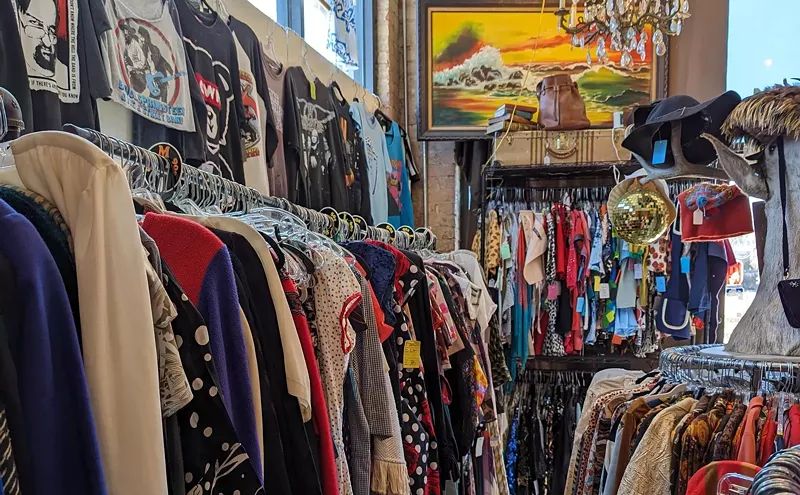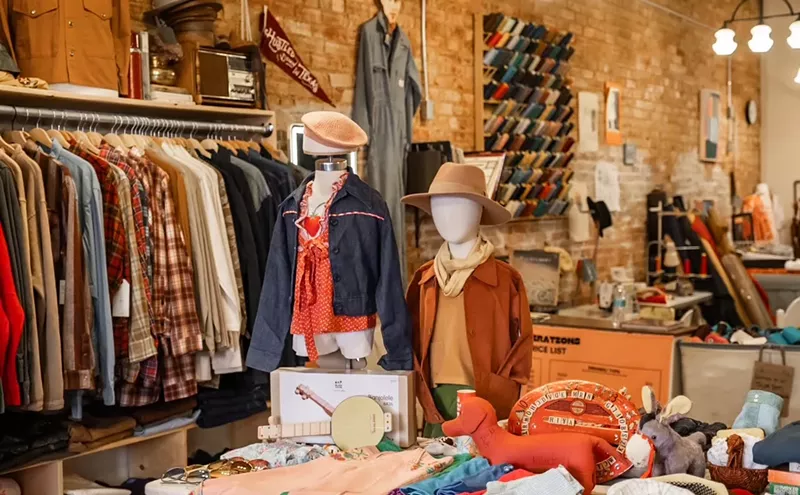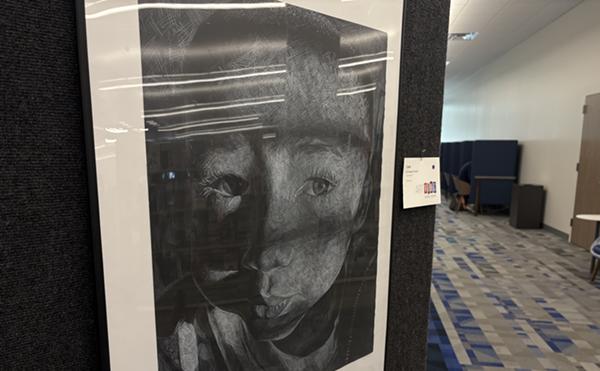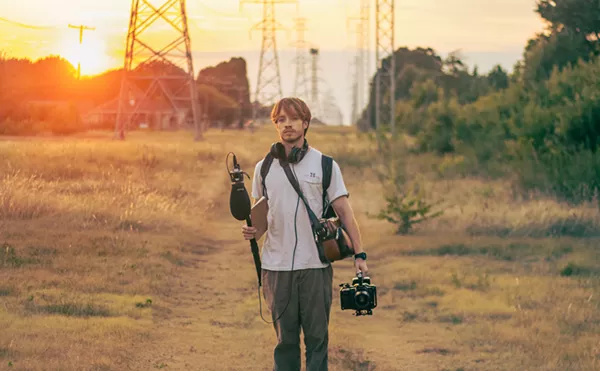There's a peculiar magic that surrounds creation. A collision of matter, sparked by energy, goes on to be viewed as destiny. In recent years our city has experienced a push of new life, a rupturing of culture. An Arts District was built. A museum became communal space. Public art was created to engage and interact with those who discover it. And somewhere in there we've begun reaching toward a better appreciation and understanding of who we are. The possibilities for what comes next feel electrifying. Infinite.
It's an exciting time to be in Dallas and to examine its culture, stew over its potential growth and reflect on those responsible for its current momentum.
Here at the Dallas Observer, we do that annually through our Masterminds awards, surveying the cultural landscape -- film, visual art, stage, activism -- to identify and honor those fostering our city's artful eruption. The parameters are intentionally loose. We might select an artist whose contributions over several decades proved pivotal for our city's evolution. We might choose a new name whose bold decisions changed how we communicate with and relate to the world. We might pick someone who makes us simultaneously laugh, think and wonder. But once we find them, we declare them Masterminds. Then, we throw money at them.
We selected six winners this year, and I'll hand a check for $1,000 to them Saturday at Artopia, our annual art-fashion-dance party. You should join us for that at Three Three Three First Ave., a restored 1926 industrial building with stunning panoramic views of our city. We'll have runway shows, dance groups, performance artists, live music, a magician, visual artists, a ceremony for these Masterminds and probably way too much tequila.
Selecting these winners from the field of talent wasn't easy. I leaned heavily on a collection of thoughtful minds, composed of members of the art community and last year's Masterminds. Weighing in from 2013's batch was photographer (and storytelling treasurer) Dylan Hollingsworth; flamenco dancer extraordinaire Delilah Muse; video artist Carolyn Sortor; performance artist and community organizer Erica Felicella; the twistedly wonderful chimeral minds of Brian K. Jones and Brian K. Scott; and the brilliant director and set designer Jeffrey Schmidt. From the city at large I lured in art critic Betsy Lewis, Ro2's co-owner Jordan Roth and Danette Dufilho, the director of Conduit Gallery's experimental project space.
Once all were inside the Observer conference area, I locked the door. When we finally emerged, weak and shaky, the space resembled a tattered war room.
Very few beers remained intact.
Read all about this year's recipients in the following pages. They can do whatever they like with the money, whether it's developing a new branch or work, framing pictures for their next big show or just finally paying off that bar tab at the Double Wide. We just hope the $1,000 helps them do what they do best: create. --Jamie Laughlin, culture editor
"We're not just interested in teaching these kids how to act," Fun House Artistic Director Jeff Swearingen says. "We're teaching them what it means to be an artist. To be part of a community."
Since its establishment in 2011, Swearingen and co-founder Bren Rapp's fledging company has challenged the standards of children's theater. They treat the preteen and high school actors like professionals, expecting them to show up on time, memorize their lines and listen to direction. They focus on each actor's growth, refuse to put up with divas, and don't even get them started about stage moms.
"From the beginning we made it our mission that we wouldn't dumb it down for the kids, which means Jeff is going to give notes on what they did wrong," Rapp says. "Sometimes that doesn't make the mothers too happy."
A mother of a teenage actor herself, Rapp met Swearingen when he was teaching at Plano Children's Theatre. They were both tired of pay-for-play productions of Grease and Princess and the Pea. Rapp noticed Swearingen holding the kids to a higher standard, so she approached him to ask if he would be interested in starting his own company. She put her marketing career to work and drafted a business plan; he began to plan full-length productions of Shakespeare and adaptations of Mamet.
"We were going to ask critics to come to Plano to review kids in productions of Hamlet and Edward Albee," Rapp says. "My friends called it 'career suicide.'"
Instead, theater critics and audiences were immediately enamored. The young casts made year-end lists and the DFW Theater Critics Forum gave an unprecedented award to an 11-year-old actress from Daffodil Girls, the re-imagining of Glengarry Glen Ross.
"I've been saying it for years and I think I'm finally proving it, kids are really freaking smart," Swearingen says, laughing. "They're like little sponges, soaking in everything from Chekhov to how to tell a good joke."
In addition to the productions, Fun House Theatre and Film offers summer workshops where students learn theater history, read important playwrights, study different acting techniques and practice improv comedy. If Swearingen and Rapp have anything to do with it, these teenagers will enter college with any tools they will need.
"We might sound like proud parents," Swearingen says, flashing a toothy grin, "but I'm excited to see where some of these kids end up in 10 years." -- Lauren Smart
Weiss is the man behind the Dallas Videofest, now going into its 27th year, and an independent film director, producer and editor. He's been a video columnist for The Dallas Morning News (among others) and teaches art and history at University of Texas at Arlington. So it's no surprise he's media-obsessed.
"We live a very mediated existence," he says. "There's so much media out there the problem is how to find what's uplifting. ... After 20 minutes on a phone or laptop no one says, 'Boy, that was a really productive time.'" Weiss is fixated on finding ways to make the time we all spend in front of a screen worthwhile.
Eschewing the popular juggernauts of film festivals, like Sundance, Weiss follows lesser-known festivals like INPUT around the world, watching for films for bringing back to Dallas. In 2013 the Videofest screened True Tales, the story of Tami True, a dancer at the Carousel Club run by Oswald assassin Jack Ruby; Vessel, about Women on the Waves, an organization that travels to countries where abortion is illegal and carries women into international waters to perform the procedure; and footage recorded from Google Glass, the company's new eyewear computer.
Originally from Philadelphia, Weiss moved to Dallas in the early '80s, when he says it seemed like everyone in the country was moving here. He spent his free time working at music video clubs, showing Talking Heads videos as soon as they were released thanks to connections he made at local offices of major recording labels.
"I believe profoundly that you can change the world through media," Weiss says. Audio and video are unique among media for their power to install empathy (Weiss believes that commercials featuring African-American families did more than anything else to humanize them for the rest of the country), and he feels an almost moral duty to bring to light stories people wouldn't see otherwise. That extends to films and media Weiss makes and ones that he brings to the festival.
Unlike many artists who feel drained by teaching, Weiss thrives off the creative energy of his students. Between organizing for the festival and teaching his classes, Weiss still finds time to work on his own projects. In April, Frame of Mind, the show he produces for local public television, returns for an eight-episode run. He's close to finishing a documentary on the Denton-based polka band Brave Combo, the headliners for the first concert in West after the disastrous fertilizer explosion. Brave Combo, according to Weiss, were perfectly suited: "Listening to them makes you feel joyous in a way that few things do." -- Luke Darby
"Latinos in the U.S. don't just need cultural or ethnic arts, but these culturally specific arts experiences can be extremely powerful," Lozano says. "I have seen people walk out of the theater saying that they have never seen anyone like them before on a stage. Or they'll say they have never seen their own story or their parents' story in a play before."
Growing up Latino in Dallas in the '80s, Lozano attended Jesuit College Preparatory School. He says his parents spoke Spanish to each other but never to the kids. When he began to study acting at Richland College and later at University of Texas at Dallas, theater became an entry point to understand many of the Latino struggles that he may not face himself. By crafting and producing shows like Crystal City 1969, which commemorates the historic Mexican-American student walkouts, Lozano says he began to further understand the discrimination his parents faced as Latinos in Texas.
"I think this is our company's fundamental mission," Lozano says. "To allow Latino audience members to process their own complex experiences. A live theater performance can do that in ways that a news article, a lecture, a movie, film or book can't."
When Adelina Anthony and Eliberto Gonzalez founded Cara Mía in 1996, Teatro Dallas was the only other company interested in Latino stories, but they were pursuing a global perspective. Cara Mía became the first company dedicated to the Chicano experience, to the stories of Mexican-Americans. Lozano has served two different terms as artistic director of Cara Mía, returning to the company in 2009 after a brief absence. Both times, he's focused on reaching the entire Latino community with new, locally focused work.
"Why produce a play about Latinos in New York or Los Angeles, written in the '80s or '90s, when our artists and I have our own experiences, ideas, collective imaginations that we can draw from?" Lozano asks. "I didn't want our company's voice to be dictated by a playwright. I wanted our plays to be the voices of our artists."
In 2012, The Arts Community Alliance (TACA) awarded the company a grant to develop a trilogy of plays about American immigration based on interviews with immigrants in Dallas/Fort Worth. The first in the series, The Dreamers: a Bloodline, premiered at the Latino Cultural Center in June 2013.
"The natural makeup of our company creates a perspective that goes beyond just the lens of the U.S. experience," Lozano says. "I feel that we have achieved the ability to listen to what's going on in our Latino community in Dallas and feel what is important to them." -- Lauren Smart
In its heyday, Bishop brought Maya Angelou, Alex Haley and former Poet Laureate Gwendolyn Brooks to the city and was instrumental in the formation of the African American Museum and the Dallas Black Dance Theater. After it closed, Paul Quinn College wound up taking over the premises and, according to Meek, everyone in the city seemed to stop talking about Bishop, as though it never existed. Installed at Paul Quinn, the site-specific "Black & Blue" aims to tell the story of Bishop College and its role in Dallas history.
"My work is about reclaiming African-American history," she says, and her contribution to the Nasher Xchange is just a small part of that. A native of Philadelphia, Meek now heads the South Dallas Cultural Center, where she's been since the late '90s. Since opening in 1986 the SDCC has been dedicated to presenting, producing and ultimately preserving the culture of the African diaspora, particularly through excellence in the arts. It's been instrumental in linking young and developing African-American artists with vital resources as well as providing arts education and role models for children.
In the world of arts administration many artists struggle to find a balance between creative and managerial work, but Meek says administrative work doesn't sap her creative energy and she shifts from one role to the other easily. "I've never been only one thing," she says. "I'm a lots-of-balls-in-the-air kind of artist."
That versatility is a product of entering the professional world after getting her MFA at the University of Wisconsin-Madison in 1974. There were few opportunities for black women in mainstream art and Meek says she never had any interest in being a starving artist. So she augmented her work as an artist where she could, first teaching at Kentucky State University, then making the transition into arts administration.
Today the SDCC is a 34,000-square-foot facility that houses a visual arts gallery, a 120-seat theater, multiple dance companies, the Soul Children's Theater and a digital recording studio. Her office has become a repository for anything valuable, extraneous, or just in need of storage, like CDs or a set of trumpets for the youth music program. The center works with similar organizations in West Africa and the Caribbean, including a youth trip to Senegal in 2008 (and another planned for 2015), where the center has developed ties with the minister of culture, and a folklorico company in New York based in Cuba. Meek is also finishing the details of a program through the Japan Foundation that would focus on similarities between jazz and traditional Japanese music.
As a city entity the center gets a small budget from Dallas, plus funding from wherever Meek has been able to find it. "My goal was to put this place on the national and international map," she says, and she's done it. The center is now in the process of securing funding from the National Endowment for the Arts, a huge milestone for both Meek and the people the center reaches.
"You can have all the museums you want, but if you don't have living artists to put in them eventually you'll run out." -- Luke Darby
"There is always something else that needs to be done from fundraising to paperwork," Fontenot says. "But I always find time to paint. The weeks when I don't, I feel like something is amiss."
Fontenot and I are sitting outside Murray Street Coffee in Deep Ellum, just a few feet from the rack where he locked his bike. During the hour we chatted, several local artists stopped by our table to say hello, including Sally Glass, a former resident of CentralTrak and founder of semigloss. magazine.
"Accepting the position of director was my way of putting community in front of my own art," Fontenot says. "If I wanted the arts to grow, I knew I needed to invest in them." Fontenot moved from Austin to Dallas for a residency at CentralTrak as an artist and became the project's director in 2011. A native of Louisiana, Fontenot studied radio, television and film at UT and worked in the industry for decades on projects that vary from experimental film to the History Channel's Swamp People to more adult subjects. He's also earned a national reputation for his paintings of nudes, a subject that has fascinated him since childhood.
"I grew up Catholic and gay. When I was a little kid my mother was always repainting the wall in my closet," Fontenot says. "I would lock myself in there and draw naked ladies behind the clothing. I don't really know why at the time, but later in my life the symbolism of that is pretty rich."
His paintings of nude friends and models are more intimate than erotic. Often Fontenot takes photographs of single subjects and paints them into groups to build an implied narrative. In each painting he "interprets" the person by exaggerating the size of heads or hands and the subjects' wide eyes seem to invite the onlooker to continue looking. "Art doesn't just exist on its own, it interacts with its public," Fontenot says. "I think there can be humor in art and I think you can see that in much of my work."
Although Fontenot may find less time to paint than he did before working at CentralTrak, in many ways his two careers complement one another. He continues to exhibit his own work throughout the country, while also expanding the number of exhibitions at CentralTrak, bringing in panels on a variety of subjects, and last year Glasstire named the space one of the best contemporary art galleries in Dallas.
"When I came to Dallas, I found this city very welcoming, but much of the support was institutional and not for the artists," Fontenot says. "Growing up on a farm, I understand the importance of being an active part of a team. We're not allowed to not participate in this. We all have to contribute to the arts community in Dallas for it to grow." -- Lauren Smart
Engelstad is a world traveler with a talent for networking (she and her partner have even started a tea importing business, Zakti, which supplies tea from plantations and farms she's visited to places like Bolsa and The Hospitality Sweet), and it's her extended web of connections that gave rise to the collaborative Make Art with Purpose.
MAP is an international program that focuses on art with a bent toward social justice and advocacy. The exact focus can be anything: immigration, climate change, education reform.
Engelstad describes it as broad with many points of depth, spanning all the continents and burrowing deep into thorny issues like asylum seeking and refugee communities. MAP was established in 2010 and this past year was the first MAP Festival, which took place in Dallas. Around two dozen public art works went up in the city, the last of which has just been taken down: "Instrument for Listening," by Slovakian artist Oto Hudec, was a massive wooden megaphone at Belo Garden in Oak Cliff meant to amplify the concerns of the Latino youths Hudec worked with.
Engelstad is a former Fulbright Scholar and trained photographer, though she decided in the late '90s to stop physically making photographs since the process she used produced so much chemical waste. This was before the advent of digital photographs, so she committed herself to art that didn't involve producing objects.
A Seattle native, Engelstad now splits her time between Dallas and San Francisco and works as an affiliated artist at the University of California at Santa Cruz's Social Practice Arts Research Center. The collaboration and administration is an extension of the creative process for Engelstad, and she compares it to the group effort that goes into film production.
The MAP website is not an archive: It's a how-to manual. Along with descriptions of the various projects, there are instructions to replicate, rebuild, reinstall or re-enact them as the case may be. Updates have been spare this year since the festival was happening, but in 2014 Engelstad expects the number of cataloged projects to double.
Twenty years ago, while working on her MFA at New York University, Engelstad's work kept her fairly isolated. She still found time to volunteer, though, teaching photography to homeless youths, but she quickly learned that it wasn't enough to simply show up and then leave. The kids kept asking her, "What's next?" Though she eventually set up a summer program to continue the work, constantly trying to answer the question "What's next?" is what pushed her away from gallery work and toward MAP.
"That's not to negate studio art and the value of going to a museum or a gallery and seeing a beautiful painting and having the experience of transcendence, because it brings pleasure or a new depth of understanding," she says. "But for my own work, I can make a more valuable contribution doing this than putting up a series of landscapes."-- Luke Darby












